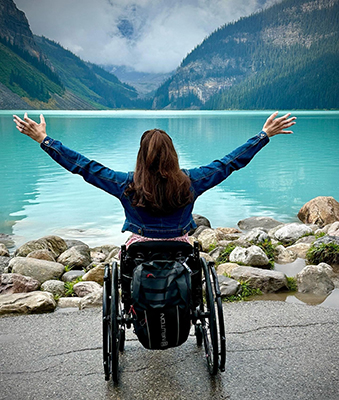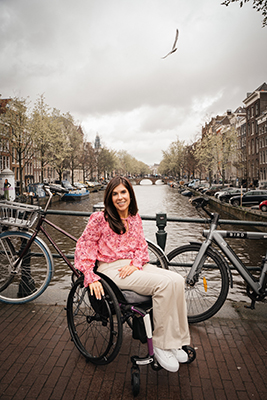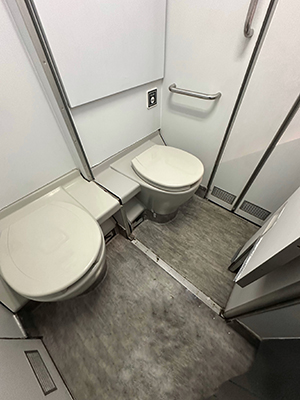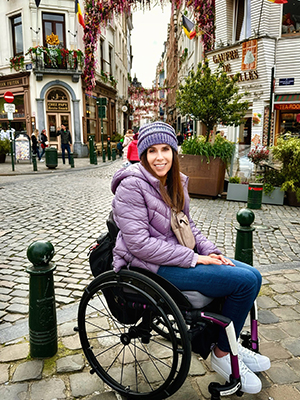By: Cheryl Angelelli
Rolling across the Great Wall of China, taking an elevator to the top of the Eiffel Tower, going on a safari tour in South Africa; these are just a few of the amazing travel experiences I have had since becoming a quadriplegic in 1983 due to a spinal cord injury.

I love to travel! My husband and I have a huge map in our home where we stick black pins in all the places we have been, and red pins in places that are still on our bucket list. So far, I have traveled to over 30 countries.
Vacation travel should be fun not stressful. However, as a wheelchair user it does require careful planning and some special considerations that will help make the experience smoother and more enjoyable. So besides packing your patience, here are a few pro tips:
Do your homework
Research…research…research. Whenever I am planning a trip, I always do my research. A great place to start is going online to research the city or country you’re visiting. Most locations have accessibility guides online that provide information on accessible transportation, attractions, and accommodations. Recently, I have started researching a trip to Iceland and have found lots of helpful information online. If you don’t feel like doing the legwork yourself, there are also some travel agencies that specialize in accessible travel that can help you plan all aspects of your next trip.

Packing
I always pack extra catheters when I travel, especially when I’m crossing time zones. The time difference interferes with my normal cathing schedule and when I take my anticholinergic medication for my neurogenic bladder. This disruption sometimes results in me going to the bathroom more frequently until I can get acclimated and back into a schedule.
If you don’t have solid, airless tires, consider packing a small travel size air pump and/or replacement tubes for your wheelchair tires in case you need air or get a flat.
Carry-on must haves
When flying, I also make sure my Coloplast catheters, medications, and other medical supplies are in my carry-on bag. Checked luggage can get lost or delayed, so those essentials are the last things you want to be without. I also make sure to bring my wheelchair cushion so I can sit on it during the flight. This is especially important on long international flights. A pressure sore is not the type of souvenir you want to come home with.
In-flight wheelchair storage
If you’re flying, take extra steps to protect your wheelchair. If the onboard closet is big enough, the airline is required to store your wheelchair onboard. If your chair must be stored in the cargo hold, be sure to take easily removable items off such as side guards, armrests, or footrests, and store them in the overhead bin or closet.
I always like to take a photo of my wheelchair that is time and date stamped before I get on the plane. That way, if there is any damage to my chair when I get to my destination, I have proof of the condition my chair was in before I boarded. If your chair was damaged in-flight, be sure to file a report immediately.
Accessible bathrooms

Did you know that most twin-aisle, wide-body planes, typically used for international flights have a wheelchair accessible bathroom? I’ll explain how it works. The accessible bathroom is actually two regular bathrooms side by side that are divided by a soft wall. When I need to use the bathroom, the flight crew removes the divider, which makes it one big bathroom that an onboard aisle chair can fit into. If you are not sure if your aircraft will have an accessible bathroom, check your flight seating chart or call the airline. It is never a good idea to fluid restrict to avoid having to go to the bathroom. Dehydration is not good for your bladder and bowel program and can make jet lag symptoms worse.
Once I reach my travel destination, finding accessible restrooms can sometimes be a challenge, especially in foreign countries which do not have the same accessibility requirements we have in the US. A helpful free app to have is Coloplast’s WheelMate. It displays the nearest wheelchair-friendly toilets and parking spaces on an interactive map. The locations are added and verified by actual wheelchair users for accuracy.
Accessible accommodations
When making hotel reservations, I like to stick with large hotel chains, as they seem to be more disability friendly. However, it is still best to call the hotel directly. Their idea of “accessible” might not meet your individual needs. Contacting the hotel to find out the bed height, door widths, and whether they have an accessible tub or roll-in shower might even help address and correct some problem areas before you even arrive.
After being stuck on the 32nd floor of a hotel during an emergency evacuation when I was traveling alone and the fire alarm went off, I always request a room on the lower floor when I check-in or book my stay. Because elevators are non-operable during an emergency.

Accessible Transportation
To avoid costly non-medical transport services as well as cabs and other ride-hailing services, always seek out public transportation when available. For example, during my recent trip to Amsterdam, I stayed at a hotel next to the train and tram station. For a nominal fee, I purchased the City Card and was able to travel all over the city on their accessible trams. Each tram has a folded ramp, but at some stops I had to ask for it or they would not pull it out for me. From Amsterdam, I was also able to take the Eurostar train to one of my favorite cities, Brussels, Belgium, for a day trip. It is less than two hours away by train from Amsterdam’s Central Station, and I was excited to travel with Eurostar for the first time. For Eurostar passengers who use a wheelchair, you’re automatically upgraded to “Premier” class, but you only pay for a standard class ticket. Premier comes with complimentary food, snack and beverage service. You can also bring a companion with you at a discounted rate. However, I learned a hard lesson, even though I booked a “wheelchair accessible” ticket, you still have to request a ramp to get on and off at least 48 hours in advance. After a lengthy discussion with the train manager, they finally accommodated me and provided a ramp. It was a good lesson in “never assume.” I’ve never done an overnight trip on Eurostar or Eurail, but friends have said the accessible sleeper cars are massive.
Insurance
In addition to purchasing travel insurance for trip cancellation and disruptions, I always purchase medical insurance as well when I travel internationally. Not all insurance policies cover medical costs if you need to seek medical attention or have an emergency while traveling abroad. Contact your health insurance to find out what might be covered and what is not. There are several companies you can use to purchase both medical and trip insurance – I personally use Seven Corners when I travel internationally. For a nominal fee, you can have peace of mind knowing that you are also protected should an unexpected health issue occur during your trip. Hopefully these tips have inspired you to get out and see the world. May your next journey be filled with excitement, lots of memories and safe travels.
Cheryl received compensation from Coloplast to provide this information, but reviews and opinions are her own. This information is for educational purposes only and should not be interpreted to contain treatment recommendations. Each person's situation is unique so your experience may not be the same. You should rely on the healthcare professional who knows your individual history for personal medical advice and diagnosis. Prior to use of SpeediCath or other product, refer to the product 'Instructions for Use' for intended use and relevant safety information.
SpeediCath® Compact catheters are prescribed for use by patients who require bladder drainage due to chronic urine retention or post void residual volume (PVR). Before use, carefully read all of the instructions. Call your doctor if you think you have a UTI or can't pass the catheter into the bladder. For more information regarding risks, potential complications and product support, call Coloplast Corp. at 1- 866-226-6362 and/or consult the company website at www.coloplast.us.